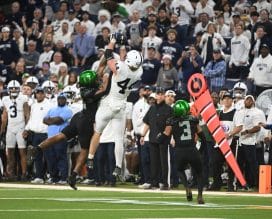Writer: Matt Rappa
Is Commissioner Manfred Avoiding the Truth Behind Declined Run Production?
Baseball, the game recognized as America’s pastime, is in danger of losing its appeal to the younger demographic as offensive run production continues to decline throughout Major League Baseball. Making changes to reverse this trend has already been prudently considered by Rob Manfred, the tenth and newly-named commissioner. Manfred, who assumed office last month, is the successor to Bud Selig who now holds the title of “Commissioner Emeritus of Baseball”. Selig will serve as a mentor to Manfred, and will be available to ‘assist with special projects’, according to a press release from MLB.com.
Figure 1 below graphically represents the overall, widespread decrease in offense over the past 30 seasons. The FanGraphs.com-provided statistical data which makes up this graph is based on the league-wide, team average for each respective season. Notice that the light blue line, which represents runs scored, decreases over time.
Figure 1: Major League Baseball offensive league averages over the past 30 seasons, excluding the 1994 and 1995 shortened seasons due to 1994-95 Major League Baseball strike from 8/12/94 – 4/2/95 (948 games cancelled in 1994 (20.8% of total games), 504 games cancelled in 1995 (11.1% of total games)).
The steady decline in scoring over the years and thus the increasing dominance of pitching, is a trend that has already been well-acknowledged publically by Manfred, after seemingly just days into his new role as commissioner. In fact, the 56-year-old, New York native has recently expressed a handful of changes he would like to see implemented in the near future to ‘inject additional offense into the game’. In a sit-down interview with ESPN’s Karl Ravech, the commissioner revealed one of these desired changes, banning defensive fielding shifts.
Another change currently being deliberated by Manfred, with the desire to increase run production, has been made public through a report published last week by Yahoo! Sports’ MLB columnist, Jeff Passan. League sources revealed to Yahoo! that Major League Baseball and its Playing Rules Committee believe the strike zone’s size has ‘sapped too much offense from the game’.
League officials, including Manfred, are proposing to alter the strike zone’s ‘textbook definition’ through elimination of what is called a ‘low strike’. Over time, it is believed that through technological advancements, umpires have been more and more uniform in ball-strike calling due to received feedback from the PITCHf/x system. Passan writes that it’s as if umpires’ performances ‘were graded on a nightly basis’. Eventually because of this system, umpires began to consistently call strikes for every square inch, or ‘smidge’, even below the knees. The more expanded a strike zone is, the more difficult it is for a batter to cover every one if its quadrants on a consistent basis.
In the report Passan cites two precursory studies, one from The Hardball Times’ Jon Roegele and the other from Florida professor Brian Mills, which uphold the league’s concern in regards to the ‘low strike’. The former study by Roegele claims that the average size of an umpire’s strike zone has increased by 39 square inches from 2008 to 2014, and that 31% of the league’s recent decline of run production can be attributed to this expansion. The latter study by Professor Mills, as noted by Passan, claims that the low strike is responsible for between 24% and 41% of the league’s deficiency in run scoring. Figure 2 below shows this deficiency, and that 2014’s league-wide average was the lowest Major League Baseball had seen over the past 30 seasons.
Figure 2: Average runs scored per game in Major League Baseball over the past 30 seasons. The year 2000’s 5.14 runs scored per game average is the highest since 1925’s 5.13 ratio. 2014’s 4.07 ratio was the lowest since 1942’s 4.08 ratio. Note: The symbol “*” indicates the shortened strike seasons.
The assumption from this Yahoo! Sports report, in that the expansion of the strike zone is represented as the significant ‘culprit’ to the decline of run production, is very misleading. The article fails to mention any other possible explanation for such change, and it only blames the people calling the strikes rather than the players that are throwing and batting themselves, creating a one-sided, biased argument.
A much more accurate explanation in which involves the players of the playing field, can be made to explain the league-wide decline of run production, as seen in Figures 1 and 2. Consider Figure 3 below, which uses the same data from Figure 1, only now narrowing-in to the previous ten seasons as opposed to the previous past 30. The peak point for hits, runs, runs-batted-in and home runs on this graph appear to have occurred somewhere around years 2006 and 2007. The rate of strikeouts, or slope of the yellow line, increased during this same time frame.
Figure 3: Major League Baseball offensive league averages over the past decade.
When researching for a possible explanation as to why all of these significant offensive categories began to dip around years 2006 and 2007, I was immediately was drawn to two significant events in the history of the league.
Despite being banned since 1991, testing major league players for steroids (a performance enhancing drug), did not exist until November of 2003. The system was very lenient, and only called for random testing with little-to-no consequences if a player in fact tested positive. After changes were made to the program in 2004, which required two tests from each player during the season, it wasn’t until 2005 when the program finally became strict in penalty. This change came after a recommendation from the United States Senate. During this time, stimulants such as amphetamines were added to the banned substances list.
In March of 2006, commissioner Selig announced that former Maine Senator, George John Mitchell, Jr., would lead an independent investigation on the Bay Area Laboratory Co-Operative (BALCO) and the associated players that used performance enhancing drugs under their name. This investigation would date back only to 2002, the signing of collective bargaining agreement with the Major League Baseball Players Association (MLBPA).
Names of 89 major leaguers, including Barry Bonds, Roger Clemens, and Jason Giambi, were linked to this investigation upon release of his 311-page report under the title, “Mitchell Report”. Mitchell encouraged further, strict enforcement of Major League Baseball’s Joint Drug Prevention and Treatment program. As a result, modifications were made in 2008, adding more banned substances and increased testing.
Three years later in 2011, Major League Baseball players and owners agreed to blood testing for human growth hormones, and in March of 2014, increased stipulations were modified to the policy. Table 1 below provides an overlook of how the testing program became stricter over the years.
Table 1: Consequences of testing positive for performance enhancing drugs over the years.
|
|
November 2003 |
January 2005 |
November 2005 |
March 2014 |
|
1st Offense |
Counseling/Treatment |
10-day ban |
50-game ban |
80-game ban* |
|
2nd Offense |
15-day ban or fine up to $10,000 |
30-day ban |
100-game ban |
162-game ban* |
|
3rd Offense |
25-day ban or fine up to $25,000 |
60-day ban |
Lifetime ban |
Lifetime ban |
|
4th Offense |
50-day ban or fine up to $50,000 |
1-year ban |
|
|
|
5th Offense |
1-year ban or fine up to $100,000 |
Commissioner discretion |
|
|
|
Additional Notes |
|
|
Stimulants banned for 2006 season |
* Ineligible for postseason; loss of salary on 2nd offense. |
Taking into account the timeline of performance enhancing drug testing and analyzing Figures 1 through 3 above, I truly believe that the stricter enforcement of the program for the first time in 2005 impacted the sudden drop in run production the most in Major League Baseball, not the alleged widening of the umpires’ strike zone reported in Jeff Passan’s Yahoo! Sports column.
Mitch Williams, professional baseball player from 1986-1997 and former MLB Network & FOX Sports analyst, shared to me his opinion regarding the impact preventing performance enhancing drugs has had on offense in the game.
“I say if [league officials] want more offense, [they should realize that] it is back to where it used to be,” said Williams, who is infamously remembered in Philadelphia for giving up the 1993 World
Series-clinching home run to Joe Carter of the Toronto Blue Jays.
“[Traditionally,] hitters would leave Spring Training swinging a 34-ounce bat, and when August came they had to adjust and drop [its weight] after 100 games. When hitters were using PED's their bodies didn't break down. They had 62 more games to put numbers up.
The recent decline in offense is the strict enforcement of drug testing. We are finally getting back to normal. The human body breaks down the hitter.”
Being able to physically contribute consistency throughout the season was one of the driving factors for widespread PED usage throughout baseball. Naturally, pitchers have the competitive advantage over batters because they are much more durable to last due to stamina training. When batters take PED’s, they even the playing field, and often are put at an even greater advantage than the pitcher that is on the mound. Clearly, the longer one can perform at a high level, the more they can contribute to games, thus yielding a higher, awarded salary when the time comes to sign a new contract.
Consider Barry Bonds’ historic 2001 season as an example. He hit for 39 home runs and 73 runs-batted-in during the first half of the season, with nearly identical numbers in the second half: 34 home runs and 64 runs-batted-in. Bonds, 50, has the most home runs, walks, and intentional walks all-time with 762, 2,558 and 688 respectively. His tainted reputation being linked to PED’s, however, may forever prevent him from earning his way into the Hall of Fame.
Williams concluded in our conversation with the belief that changing the rules of the game, such as raising the strike zone as suggested by commissioner Manfred, is not the proper way to go about increasing run production.
“I say hitters need to work harder and smarter. It is simple. Hit better, and make adjustments. You can't change the game to suit hitters. The game is great. Players need to figure out how to [manage] the weight of their bats to allow for fatigue. We have an entire generation that never learned that.”
19 suspensions were handed-out from 2005-2007, totaling 470 games. As time went on, and up to even today, penalties have transformed from what was then just a “slap on the wrist” first offense in 2003 to now an 80-game suspension and playoff ineligibility on the first offense.
Mike Angelina, producer for SportsRadio 94 WIP-FM and contributor to CBSPhilly.com, provided me additional insight which supports my theory, and disproves Yahoo! Sports’ report, even further.
“I attribute [lack of run production to] the lack of drugs and supplements in the game today. 162 games in 180 or so days is a lot of baseball,” said Angelina. “There are often ‘day games after night games’, which undoubtedly are harder to recover from without a supplement or two.”
Angelina, Sixerdelphia.com editor and contributor to Philliedelphia.com, then linked his opinion regarding scarcity of offense to the 2014 Philadelphia Phillies’ season, which convinced me even further that he was right.
“Look at the Phillies, for example, they played 54 day games last year, and I'd guess just about all of them were immediately following a night game How many games did we see last year in like August where Utley and Howard, two vets, just did not have anything in their legs and couldn't generate enough strength within their tired bodies to hit a ball out of the ballpark?”
While performance enhancing drugs have largely contributed to the decline in run production, there has to be other contributing factors as well. Seeking further opinion, I looked to Brian Startare, ESPN radio host for Philadelphia’s first FM sports radio station, 97.5 The Fanatic.
Though Startare, editor of Flyerdelphia.com, attributed lack of offense to performance enhancing drugs, he also linked it to evolution of more defined pitching roles within the game.
“There's something to the crackdown on PED's and the end of the steroid era. However, the pitching roles may have had some effect as well. They seem to be challenging the hitters more with less fear, and starters only go five or six innings and then the ‘specialists’ come in. That's more challenging for the hitter.”
Not only have pitchers become more accustomed and confident, according to Startare, but batters themselves have changed over the years as well.
“The art of hitting, in my opinion, has gone way. Everybody wants to hit a home run instead putting together some runs the old fashioned way. More strikeouts, less runs.”
Kyle Scott, founder and editor of CrossingBroad.com, Philadelphia’s number one, most visited sports blog, also attributed to PED’s, but like Startare had other theories behind the trend.
“The crackdown on PEDs is an obvious [reason for minimal run production], but I also think the proliferation of sabermetrics, with managers having more data to pitch and align defenses to batters’ weaknesses is a big [reason as well].”
When speculating as to why the misrepresentation might have been made regarding the increased strike zone being a major contributor to decreasing offense, it is important to recognize what prior positions Manfred held in Major League Baseball before becoming commissioner on January 25, 2015. He was the negotiator for the league’s first drug testing agreement in 2002, and he also took part in negotiations with the players’ union for new collective bargaining agreements in 2002, 2006 and 2011. In addition, he led Major League Baseball’s investigation on Biogenesis of America, similar to the BALCO, Mitchell Report investigation. Some of the game’s biggest stars, such as Alex Rodriguez of the New York Yankees, Ryan Braun of the Milwaukee Brewers, and Nelson Cruz of the Texas Rangers (who eventually signing with the Baltimore Orioles upon completion of his suspension), all missed significant playing time last season for being linked as participants of the scandal.
It is apparent that commissioner Manfred wants to find every possible fallacy in the game, other than just solely mentioning the fact that fewer players are taking performance enhancing drugs, as to explain why a recent decrease in run production has occurred in the game.
Thus, the attribution of declining offense to the gradual expansion of the strike zone, as the Yahoo! Sports article reports from “league sources”, which is surely Manfred, is not the entire truth. The report fails to mention PED’s and other possible reasons along the lines with what Startare and Scott speculated in our interviews.
Manfred and former commissioner Selig led an extensive, and near-decade long battle to clear up the tarnished reputation of the game from PED’s and restore order to ‘America’s pastime’. This struggle is still going on today, and players will continue to be suspended and test positive for banned substance. The last thing Manfred would want, however, is for controversial, scandal-filled clouds to continue lingering over his head any longer, especially under the title as commissioner of Major League Baseball. Therefore, it is plausible to draw to the conclusion that from the Yahoo! Sports report, the reader is significantly misled.
Matt Rappa (@mattrappa) is a contributor to Philliedelphia.com.





